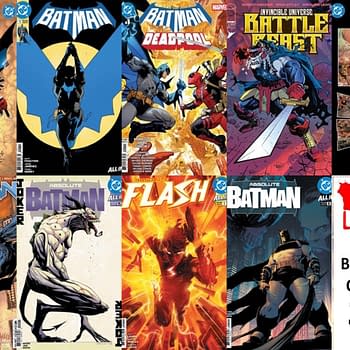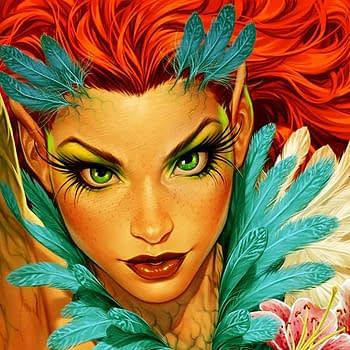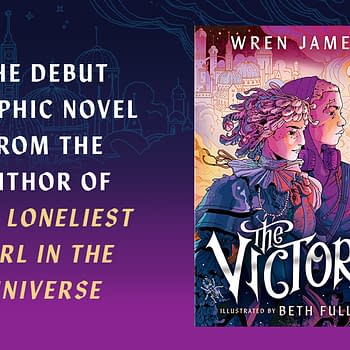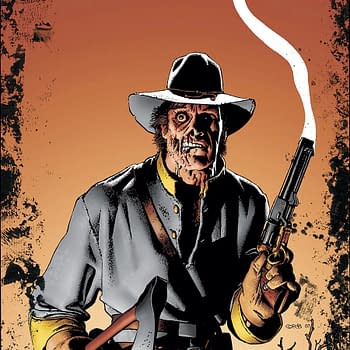Posted in: Comics | Tagged: battlestar galactica, Comics, dynamite, entertainment, Gods & Monsters, karl kesel
Every Cylon Is A Machine, Aren't They? – Karl Kesel On Battlestar Galactica: Gods & Monsters
Karl Kesel talks to Byron Brewer about Battlestar Galactica: Gods and Monsters #2, on sale in December from Dynamite. Covers by Alec Morgan and Pete Woods.

KARL KESEL: Of course, EVERY Cylon is a machine, aren't they? The Centurions happen to still look like machines, but that doesn't mean they aren't sentient or alive— they are. The difference between the 12 advanced Cylon models (who all look human) and the Centurions is that the Centurions have no (or at least limited) free will. Later in the series, you may remember, the Centurions were given free will and allied themselves with a few of the 12 models, while fighting the rest. It's unknown— even by the advanced Cylons— if Baltar gave his Centurion free will (possibly inadvertently) when he rebuilt it, or if it's still operating under the Cylon "Compliance Protocols." So I don't see where I've gone against anything established in the series. All I'm doing is taking what they established, running in a new direction with it, and seeing where it takes all the characters.
BB: Is the subtitle, "… and Monsters," speaking of Baltar's "frankensteined" Cylon Centurion? Will that entity be more a part of the story than readers at first suspected? Is it friend or foe for the Battlestar Galactica heroes?
KK: The question "Is Baltar's Centurion friend or foe?" is one that every reader should be wondering/worrying about too! The only way to find out is to read the comic. As for whom the term "Monsters" refers to— certainly the Centurion fits in the broadest sense— but I think other players in this story are different sorts of monsters, whether they know it or not.
BB: Your characterization of Baltar seems more akin (to me, at least) to that of the wonderfully mad COUNT Baltar on the 1978 TV series rather than his reimagining, the good DOCTOR. Any truth to that?
KK: All I can say is I've never seen any episode of the original show. My Baltar is the re-imagined version, best I can manage and as I believe he'd act in these situations. I don't necessarily think of him as "the good Doctor"— but he's not really evil, either. What he is, is a world-class narcissist, especially at the point in the show's continuity where this storyline takes place. They say everyone's the hero in their own, inner movie, and that definitely applies to Baltar. Except in his mind he's the hero of the biggest summer blockbuster of all time.
BB: Cavil is certainly having his way with Simon. I cannot recall anything like it in any other BSG comic book stories. Was there any inspiration from literature or life for the evil game Cavil is playing?

BB: In preparing to write this series, did you and/or artist Alec Morgan do any research as far as "looks" for the book, establishing a mood or tone for the various scenes? I am thinking especially of Caprica here.
KK: Well, up-and-coming talent Dan ("The Spirit") Schkade is drawing the Caprica scenes. That he's a different artist instantly gives those scenes a different look, which I think is great. His work is stylistically compatible with Alec's, but you know at a glance we're not on Galactica anymore. Which is kinda what they did on the show— Galactica looked somewhat drained of color, while Caprica was harshly, fully saturated.
BB: How closely are you and Alec working together, and how have you enjoyed his bringing your scripts to life thus far? (I know it is early yet…)
KK: It is early, but everything I've seen from Alec is outstanding. Because BSG is a licensed property we need to work full script, which limits a certain amount of creative give-and-take, but Alec knows he can call me up any time with suggestions or alternate ways to play a scene or ways to give a moment more depth. Which he's done. I'm all in favor of anything that makes this book better and Alec's work does that, on every level.














